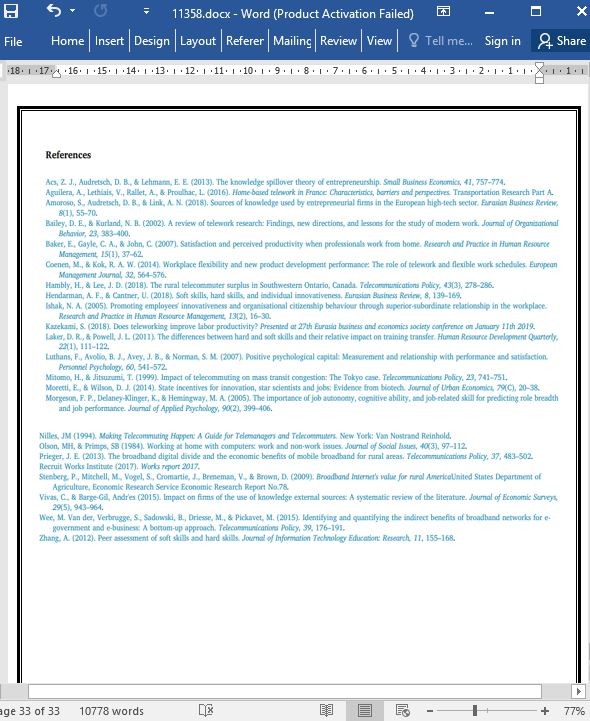
مکانیزم هایی جهت بهبود بازدهی نیروی کار با انجام دورکاری
چکیده
در این پژوهش مکانیزم های اساسی مؤثر بر بازدهی دورکاری در ژاپن بررسی شده اند. ابتدا این پژوهش نشان می دهد که ساعات کاری دورکاری مناسب بازدهی نیروی کار ار افزایش می دهد، اما اگر ساعات دورکاری خیلی طولانی باشد، موجب کاهش بازدهی نیروی کار می شود. درثانی، دورکاری رضایت از زندگی را افزایش می دهد و متعاقباً رضایت از زندگی بازدهی نیروی کار را بهبود می بخشد. باوجود این، دورکاری بر خلاف انتظارات دولت ژاپن، موجب افزایش استرس متعادل سازی بین کار و کار در خانه می شود، و این استرس رضایت از زندگی را کاهش می دهد. خوشبختانه این استرس به طور مستقیم موجب کاهش بازدهی نیروی کار نمی شود. گرچه دورکاری موجب افزایش شادی و رضایت از کار می شود، اما این عوامل تأثیری بر بازدهی نیروی کار ندارند. سوماً، این پژوهش نشان داد درصورتی که زمان رفت و آمد کارکنان بیش از یک ساعت باشد یا با قطار و اتوبوس هایی که معمولا در ساعات شلوغ ژاپن بسیار پرازدحام هستند، رفت و آمد کنند، دورکاری برای بهبود بازدهی نیروی کار بسیار مؤثر است. درنهایت، تأثیر دورکاری بر کارکنانی که وظایف بی اهمیت بالقوۀ بیشتری دارند به طور غیرمعناداری بیشتر است. سرپرستان و همکاران اغلب می خواهند کارهای بی اهمیت و اضافی را خارج از برنامۀ کاری انجام دهند. دورکاری می تواند به کارکنان کمک کند تا از این وظایف بی اهمیت بپرهیزند و بازدهی نیروی کار را افزایش دهد. با وجود این، اهمیت وظایف بی اهمیت نیز در این پژوهش نشان داده شده است.
1. مقدمه
جاامعۀ ژاپن دورکاری را ترویج می دهد1 زیرا این عمل موجب تشویق خانم ها و افراد سالخورده به کار کردن می شود و این امر به جبران کمبود نیروی کار کشور ناشی از کاهش جمعیت کمک می کند. دورکاری این امکان را به والدین می دهد تا بین کار و نگه داری از کودک یا افراد مسن برای یکی از اعضای خانواده تعادل برقرار کنند و مناطق روستایی دور از فرصت های شغلی مناطق شهری را احیا می کند. طبق نظرسنجی استفاده از ارتباطات ژاپن در سال 2016، علی رغم گزارش نطرسنجی که اظهار داشت میانگین بازدهی شرکت های ژاپنی از طریق دورکاری بالاست؛ فقط 13.2% از شرکت ها دروکاری را معرفی کرده بودند، علاوه براین 43.4% از آن ها گزارش کردند که کمتر از 5% کارمندان دورکاری انجام می دهند. دورکاری از زمان اولین بروز آن در دهۀ 1970، (آگیولرا، لتیاس، رالت و پرولاک، 2016، ص. 11-1) حتی در اروپا ( کمتر از 6% در فرانسه و حدود 6% در استرالیا) و ایالات متحده (24%-15%) نیز محبوبیت کمی داشته است. یکی از دلایل آن این است که مدیران به اینکه دورکاری بازدهی نیروی کار را افزایش می دهد، مشکوکند (آگیولرا و همکاران، 2016، ص. 11-1).
6. بحث و نتیجه گیری
در این پژوهش مکانیزم های اساسی تأثیردورکاری بر بهره وری نیروی کار در ژاپن بررسی شد. به ویژه، در این پژوهش(1) تأثیر دورکاری بر ایترس برقراری تعادل بین کار و کار در خانه =، شادی، رضایت از زندگی، و سپس تأثیر این عوامل بر بهره وری نیروی کار؛ (2) تأثیر کاهش زمان رفت و آمد و استرس ناشی از ساعات شلوغ و (3) تأثیر اجتناب از وقفه د رکار با انجام دورکاری، بررسی شد. به علاوه در این پژوهش ابتدا با استفاده از یک مدل تأثیرگذاری ثابت به منظور حذف تأثیر ویژگی های فردی مشاهده نشده، اینکه آیا ساعات دورکاری بهره وری نیروی کار را افزایش می دهند، بررسی شد.
Abstract
This study investigates mechanisms underlying the influence of telework on labor productivity in Japan. First, this study finds that appropriate telework hours increase labor productivity, but when telework hours are too long, telework decreases labor productivity. Second, telework increases life satisfaction, and life satisfaction improves labor productivity. However, telework increases the stress of balancing work and domestic chores, contrary to Japanese governmental expectations, and the stress decreases life satisfaction. The stress, fortunately, does not directly reduce labor productivity. Although telework increases happiness and work satisfaction, these factors do not influence labor productivity. Third, this study clarifies that telework is more efficient for improving labor productivity if workers commute more than 1 h or commute by trains or buses that are usually very crowded during rush hours in Japan. Finally, the effect of telework for workers who have a greater number of potential trivial duties is insignificantly larger. Supervisors and colleagues often ask others to perform trivial, extra tasks without regard for schedules. Telework may help workers avoid such trivial duties and increase labor productivity. However, the importance of trivial duties is also demonstrated in this study.
1. Introduction
Japanese society promotes telework1 because this practice encourages women and elderly individuals to work, which helps compensate for the nation's labor shortage caused by its declining population. Telework allows parents to balance work and childcare or elder care for a family member and revitalizes rural areas far from the job opportunities of urban areas. According to the 2016 Japanese Communication Usage Survey, only 13.2% of firms have introduced telework, despite the survey reporting that average productivity in Japanese firms with telework is high; furthermore, 43.4% of them reported that less than 5% of employees perform telework. Teleworking has been less popular even in Europe (less than 6% in France and approximately 6% in Australia) and the United States (15%–24%), since its first appearance in the 1970s (Aguilera, Lethiais, Rallet, & Proulhac, 2016, pp. 1–11). One reason is that managers doubt whether telework increases labor productivity (Aguilera et al., 2016, pp. 1–11).
6. Conclusion and discussion
This study investigates mechanisms underlying the influence of telework on labor productivity in Japan. Specifically, this study examines (1) the effect of telework on the stress of balancing work and domestic chores, happiness, life satisfaction, and work satisfaction and then the influence from those factors on labor productivity; (2) the effect of reducing commuting time and stress from the commuter rush; and (3) the effect of avoiding interruption at work by performing telework. Additionally, this study first examines whether telework hours increase labor productivity by using a fixed effect model to remove the influence of the unobserved individual characteristics.
چکیده
1. مقدمه
2. داده ها و تشریح دورکارها در ژاپن
2.1. داده ها
3. تأثیر ساعات دورکاری
3.1. تأثیر ساعات دورکاری بر بهره وری نیروی کار
4. استرس، شادی، رضایت از زندگی و رضایت شغلی
5. زمان رفت و آمد و وقفه در کار
5.1. زمان رفت و آمد
5.2. وقفه در کار
6. بحث و نتیجه گیری
ABSTRACT
1. Introduction
2. Data and the description of teleworkers in Japan
2.1. Data
3. Effect of telework hours
3.1. Effect of telework hours on labor productivity
3.2. Effect of starting telework and stopping telework
4. Stress, happiness, life satisfaction, and work satisfaction
5. Commuting time and interruption at work
5.1. Commuting time
5.2. Interruption at work
6. Conclusion and discussion
- ترجمه فارسی مقاله با فرمت ورد (word) با قابلیت ویرایش، بدون آرم سایت ای ترجمه
- ترجمه فارسی مقاله با فرمت pdf، بدون آرم سایت ای ترجمه



